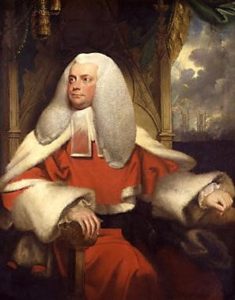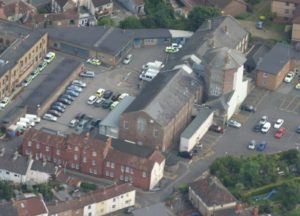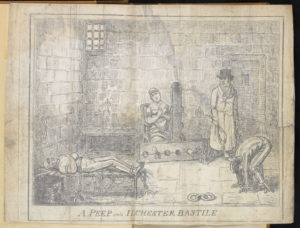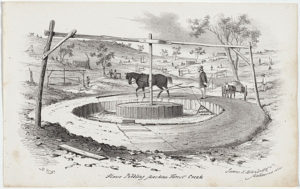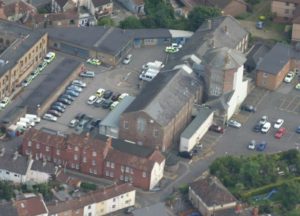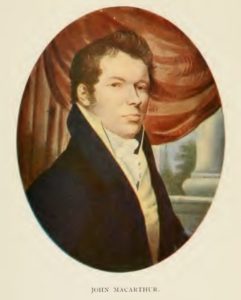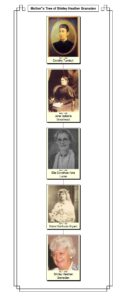Over the last month and a half I have been working on my convict assignment for UTAS. There was a lot of other reading and research that I had to do as well. Some of what I have done has already been put up here on my blog, however, much of it has not. So here are the stories that I have written for that unit. There is way more that I could have written but with the time limits and word constraints I have focused very much on the basics.
On the 28th of March 1799 Mary Stevens, a young woman of around 21 with black hair and green eyes,[1] was sentenced to Transportation over the Seas for the term of seven years.[2] Mary had originally been arrested and held at Ilchester Gaol[3] before being remanded in Custody at Taunton Castle to await her trial at the Lent Assizes.[4] Mary had stolen 17 yards of cotton, the property of Thomas Andrews[5], to the value of 30 shillings[6].
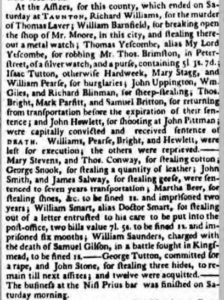
04 April 1799 – Bath Chronicle and Weekly Gazette – Bath, Somerset, England. Find My Past
The Lent Assizes of 1799, at Taunton, were presided over by the Judges F. Buller and N. Grose.[7] At the Assize Mary Stevens was the only female to be sentenced to Transportation, although four men received similar sentences. Of those who attended the Assizes with Mary three were sentenced to death and a variety of other sentences were passed including fines and hard labour for some. [8] After the Lent Assize of 1799 Mary remained at Taunton Castle for the next year until the next Lent Assize of 1800. This Assize was presided over by the Justices S. Lawrence and F. Buller.[9] At this Assize Mary’s sentence was confirmed and she was set for ‘Transportation over the Seas’ for the period of seven years.
Once her sentence was confirmed Mary was sent back to Taunton gaol until she was to go on the Ship that would take her to Botany Bay, Australia. In September of 1800 Mary, along with approximately 94-99 other women and 100 men, were moved aboard the Earl Cornwallis, then laying anchor at Downes.[10] The Earl Cornwallis had just been refitted which included it hull sheathed with copper, and the installation of a roundhouse on the stern and a new mast.[11]
Mary and the other convicts were joined by almost another one hundred convicts at Portsmouth on the 14th of September.[12] The Earl Cornwallis then moved onto Cowes on the Isle of Wight where due to Storms and administrative delays the ship was kept at anchor until mid-November.[13] Finally after close to 18 months in different prisons and almost three months aboard the Earl Cornwallis moored in different parts of the Thames, Mary and the almost 300 other convicts plus passengers and crew, started the long journey to Botany Bay.
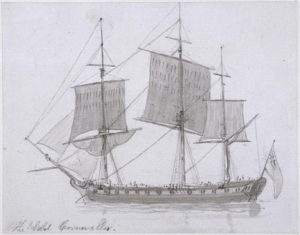
By Thomas Daniell (1749-1840) – Yale Center for British Art, Paul Mellon Collection, USA, Public Domain, https://commons.wikimedia.org/w/index.php?curid=36841826
The voyage was not without excitement. They reached Rio de Janiero around the 3rd of February 1801where the officer in charge of the guard escort of the convicts, Lieutenant Henry Crawford, fell over board and was drowned.[14] After leaving Rio de Janiero the Earl Cornwallis next dropped anchor at Cape Town. According to Scott the trip from the Cape to Sydney was particularly wet and windy.
“After a passage of 7 weeks from the Cape; it blew a continual Gale of wind most all of the passage, with most tremendous squalls”.[15]
As Mary and the other convicts disembarked in Sydney they had the first sight of their new home, a town that looked like a camp with low straggling houses. [16] It was not long before the convicts got a taste of what their new life would be, with many of them being allocated to work. Mary was assigned to the Soldier John Lees as a Housekeeper.[17]
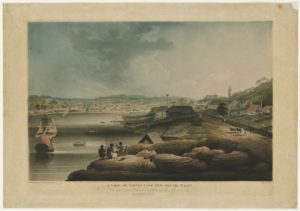
Edward Dayes, 17631804 View of Sydney Cove, New South Wales, from an original picture in the possession of Isaac Clementson Esqr. Call Number: V1 / 1802 / 1 Published date: 1802 Digital ID: a1528669 (Courtesy of the State Library of NSW)
It appears that Mary’s new life in Sydney provided her with opportunities that she may not have had in her previous home in Somerset. Just fifteen months after her arrival in Sydney, Mary gave birth to a daughter, Maria Lee, daughter of John Lees and Mary Stevens.[18] This was not the end of Mary and John’s liaison, in fact over the next 20 years Mary was to have ten children with John Lees.[19] [20] [21] [22] [23] [24] [25] [26] [27] Mary and John were also to marry although not until 1809 after the first five of their children had been born and baptised.[28]
Mary and John did not stay in Sydney. On the 24th of April 1803, just before the birth of their second child, John was discharged from the Army.[29] He was also granted the first of a series of Land Grants in Castlereagh, NSW.[30] This grant of Land meant that John, Mary and their young and growing family could move to Castlereagh and take up the lives of farmers. They worked hard and life was not easy for them. Less than a year after the family moved to Castlereagh they lost everything that they had worked for in a fire that destroyed their home. [31] Fire was not the only disaster to befall the family, they also faced severe floods[32] and caterpillar plagues.[33] Despite all of these challenges, by the time Mary was present at the 1814 Muster the whole family were off stores and supporting themselves off their own land. [34]
Mary and John lived together for 35 years until John died on the 28th of August 1836 at the age of 59. [35] Mary lived for another three years before she also followed him to the grave. [36] Both John and Mary are buried together at the Wesleyan Chapel at Castlereagh.
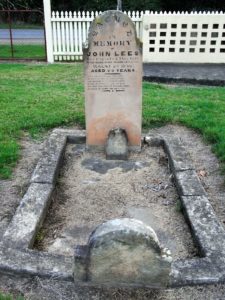
John Lees tomb stone
Authors Collection
[1] State Records Authority of New South Wales. Certificate of Emancipation, 1811. 4/4427; COD18, Reel 601 page 522-23. Mary Stevens
[2] TNA, Somerset Lent Circuit 1799 ASS1 23 9, Mary Stevens
[3] State Records Authority of New South Wales, PRO 87, HO 11/1 275-288, Mary Stevens
[4] TNA, Somerset Lent Circuit 1800 ASS1 23 9, Mary Stevens
[5] Find My Past. Bath Chronicle and Weekly Gazette, 04 April 1799. Mary Stevens.
[6] TNA, Somerset Lent Circuit 1799 ASS1 23 9, Mary Stevens
[7] Google Books. Jeffries, F. The Gentleman’s Magazine (London, England), Volume 85. 1799 Digitised 2011. https://books.google.com.au/books?id=f30dAQAAMAAJ&printsec=frontcover&dq=Gentleman%27s+Magazine+vol+85+1799+Jeffries&hl=en&sa=X&ved=0ahUKEwixn6yx6ojNAhXBEpQKHeAMD6oQ6AEIHDAA#v=onepage&q=Lent&f=false (Accessed 1st June 2016) p 147.
[8] Find My Past. Bath Chronicle and Weekly Gazette, 04 April 1799. Mary Stevens.
[9] Google Books. Jeffries, F. The Gentleman’s Magazine (London, England), Volume 87. 1800 Digitised 2011. https://books.google.com.au/books?id=uvsRAAAAYAAJ&printsec=frontcover#v=snippet&q=Buller&f=false (Accessed 1st June 2016) p 176.
[10] NLA MS 1898. Robert Scott, Fifth mate on the Earl Cornwallis, 4th Letter, 2nd September 1800
[11] Griffiths, J. A History of David Brown (1750-1836) and Family. 2016 http://www.davidbrown1801nsw.info/ (Accessed 31st May 2016)
[12] NLA MS 1898. Robert Scott, Fifth mate on the Earl Cornwallis, 5th Letter, 19th September 1800
[13] Griffiths, J. A History of David Brown (1750-1836) and Family. 2016 http://www.davidbrown1801nsw.info/ (Accessed 31st May 2016)
[14] Griffiths, J. A History of David Brown (1750-1836) and Family. 2016 http://www.davidbrown1801nsw.info/ (Accessed 31st May 2016)
[15] NLA MS 1898. Robert Scott, Fifth mate on the Earl Cornwallis, 9th Letter, 16th August 1801
[16] NLA MS 1898. Robert Scott, Fifth mate on the Earl Cornwallis, 9th Letter, 16th August 1801
[17] Marsden’s Female Muster 1806; ML ref: Vol. MSS 18, published in “Musters of New South Wales and Norfolk Island 1805-1806”, edited by Carol J. Baxter, ABGR, Sydney, 1989.; Book Entry# C1164
[18] St Philip’s Church of England, Sydney NSW: Church Register – Baptisms; ML ref: Reel SAG 90.; Vol Entry# 910
[19] NSW BDM 1804 911/1804 V1804911 4 Hannah Lee
[20] NSW BDM 1806 912/1806 V1806912 4 Richard Lee
[21] NSW BDM 1807 2621/1807 V18072621 1A John Leese
[22] NSW BDM 1809 1962/1809 V18091962 1A Mary Lees
[23] NSW BDM 1812 2622/1812 V18122622 1A Esther Lees
[24] NSW BDM 1812 3211/1813 V18133211 1A Samuel Leese
[25] NSW BDM 1815 3784/1815 V18153784 1B Timothy Leese
[26] NSW BDM 1818 4459/1818 V18184459 1B Sarah Leese
[27] NSW BDM 1821 1555/1821 V18211555 162A Cornelius Lees (noted as Sees on the BMD database)
[28] NSW BDM 1809 893/1809 V1809893 3A John Leese and Mary Stephens
[29] Biographical Database of Australia. 1803. Muster Master General’s Index of Casualties &c 102 Foot. Ref: WO25/1342. John Lees http://www.bda-online.org.au/ (accessed 31st May 2016)
[30] Biographical Database of Australia Australian Biographical and Genealogical Record – Series 1 – 1788-1841″, Eds. John T. Spurway and Allison Allen. Pub. ABGR, Sydney, 1992. http://www.bda-online.org.au/ (accessed 31st May 2016)
[31] Trove. 1804 ‘New Bridge.’, The Sydney Gazette and New South Wales Advertiser (NSW : 1803 – 1842), 26 February, p. 4. , viewed 31 May 2016, http://nla.gov.au/nla.news-article626060
[32] Trove. 1806 ‘HAWKESBURY, MARCH 27.’The Sydney Gazette and New South Wales Advertiser (NSW : 1803 – 1842), 30 March, p. 2. , viewed 31 May 2016, http://nla.gov.au/nla.news-article627063
[33] 1810 ‘SYDNEY.’, The Sydney Gazette and New South Wales Advertiser (NSW : 1803 – 1842), 29 September, p. 2. , viewed 31 May 2016, http://nla.gov.au/nla.news-article628077
[34] General Muster of the Inhabitants of New South Wales commencing on 17th October and ending 16th November 1814. edited by Carol J. Baxter, published by ABGR, Sydney, 1987.; Book Entry# 1328
[35] NSW BDM 1836 668/1836 V1836668 20 John Lees
[36] NSW BDM 1839 1027/1839 V18391027 23A Mary Stevens (noted as Stover on the BDM database, both Lees and Stevens on the actual certificate)
